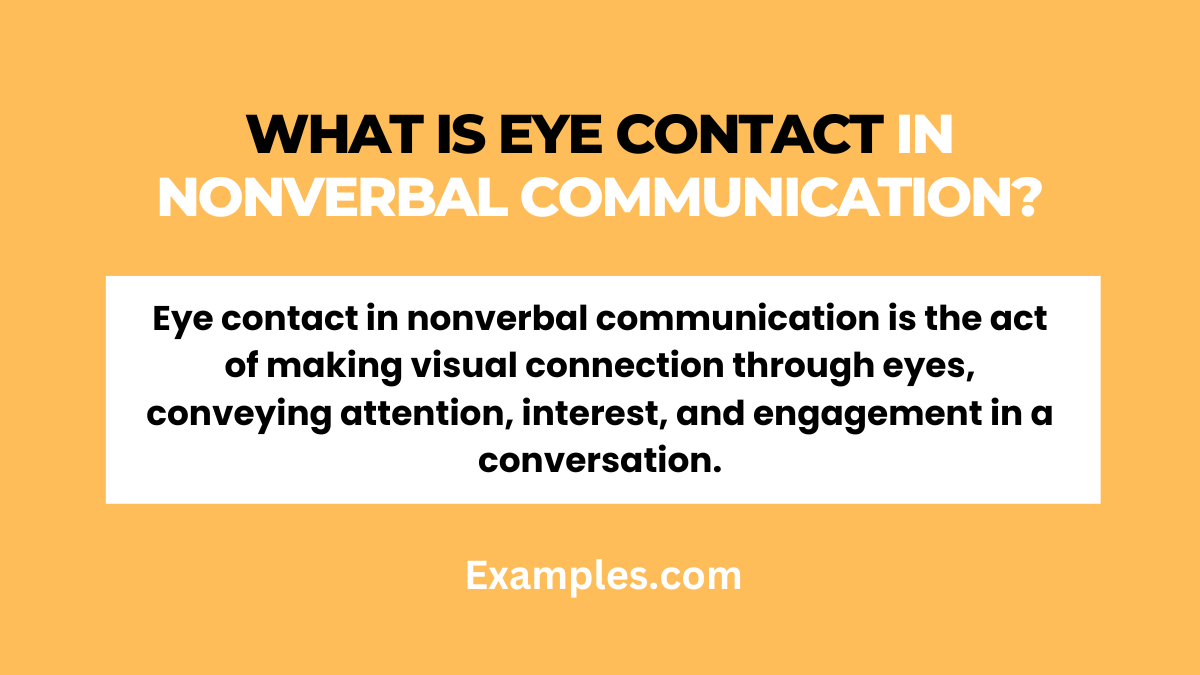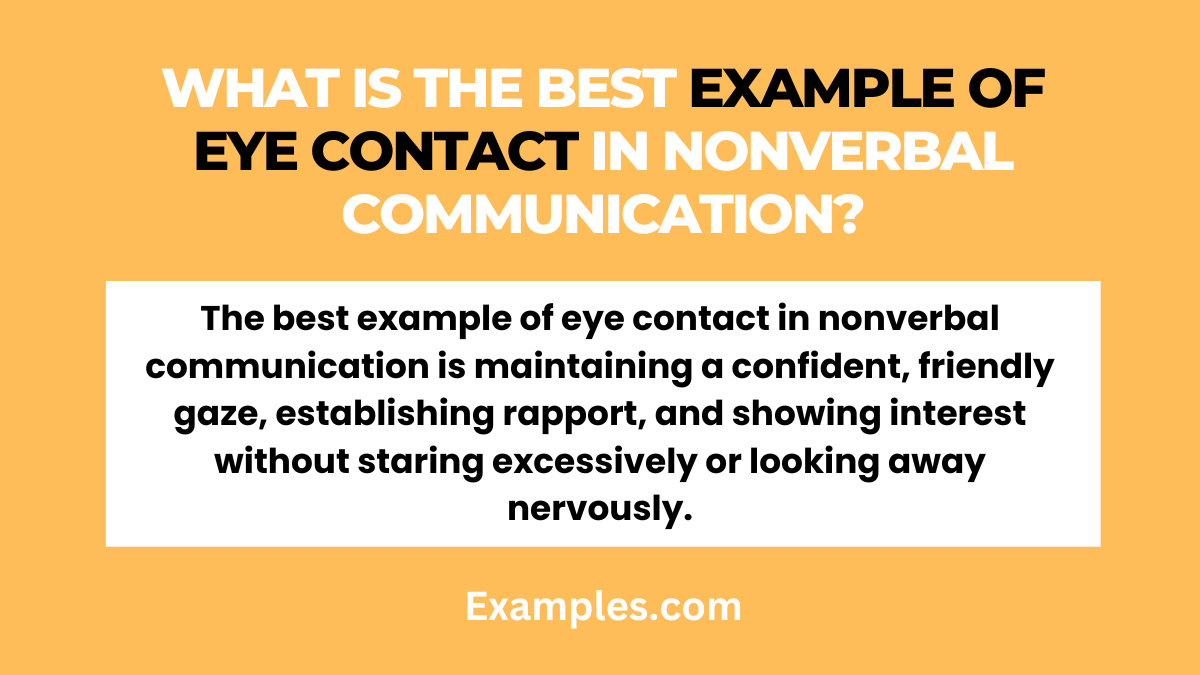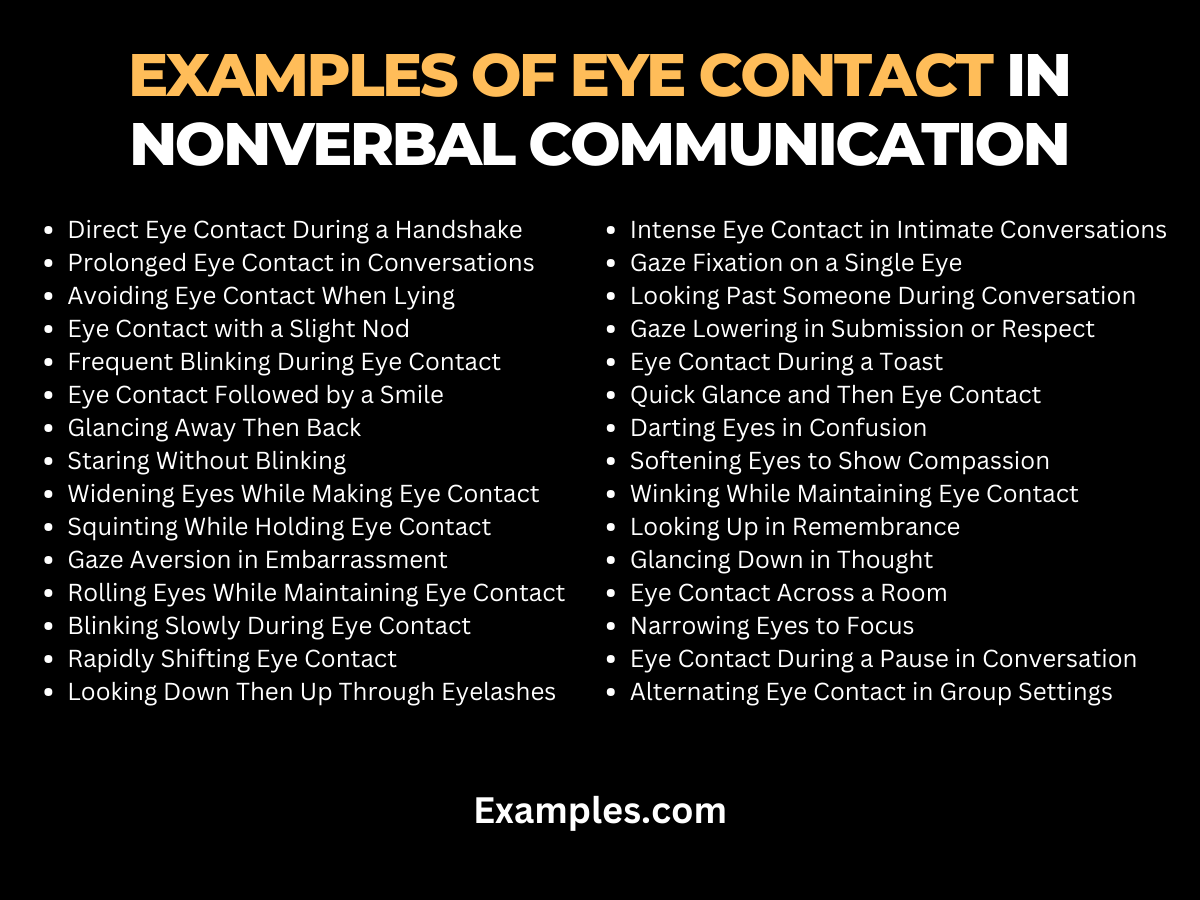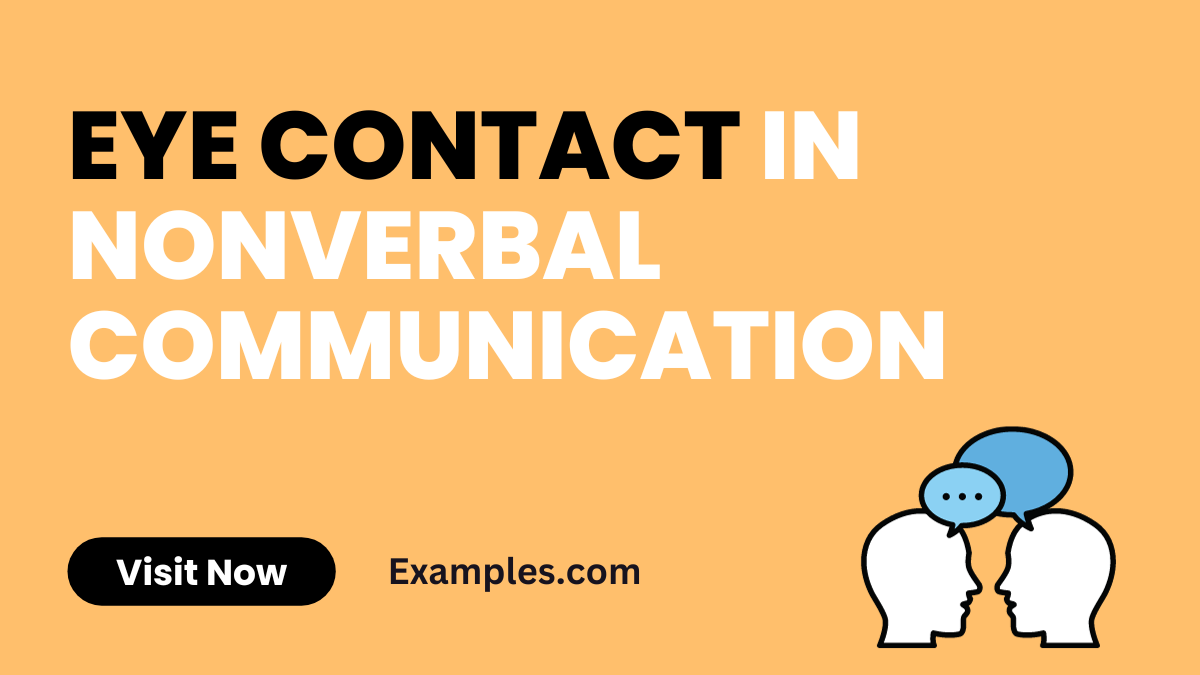29+ Eye Contact in Nonverbal Communication Examples
Understanding the role of eye contact in nonverbal communication is crucial for enhancing interpersonal interactions. It’s more than just a glance; it’s a powerful tool for conveying emotions and intentions. This guide delves into various communication examples where eye contact can make a significant difference, from professional settings to personal relationships. Learn how to interpret and use eye contact effectively to communicate more profoundly and authentically.
What is Eye Contact in Nonverbal Communication?

Eye contact, a pivotal aspect of nonverbal communication, involves maintaining visual connection with another person’s eyes. It’s a form of body language that communicates a range of emotions and intentions without words. Understanding its dynamics is essential for effective interpersonal communication.
What is the Best Example of Eye Contact in Nonverbal Communication?

A classic example of eye contact in nonverbal communication is during a heartfelt conversation. When someone listens attentively and maintains steady eye contact, it conveys sincerity, engagement, and respect. Conversely, avoiding eye contact might suggest discomfort, disinterest, or dishonesty. This nonverbal cue, when used appropriately, can greatly enhance the quality and authenticity of interactions.
30 Examples of Eye Contact in Nonverbal Communication

Eye contact is a pivotal aspect of nonverbal communication, providing subtle yet powerful cues in interactions. This comprehensive guide explores 30 unique examples of eye contact, each with a two-line explanation and a communicative sentence example. By understanding these nuances, one can enhance their understanding of nonverbal communication and improve interpersonal skills.
- Direct Eye Contact During a Handshake: Indicates confidence and sincerity.
Example: “As I shook his hand, my direct eye contact showed my genuine interest.” - Prolonged Eye Contact in Conversations: Demonstrates attention and engagement.
Example: “Her prolonged eye contact made me feel heard and valued.” - Avoiding Eye Contact When Lying: Suggests dishonesty or discomfort.
Example: “He averted his eyes when questioned, signaling potential deceit.” - Eye Contact with a Slight Nod: Acknowledges understanding.
Example: “With eye contact and a nod, I conveyed my agreement silently.” - Frequent Blinking During Eye Contact: Indicates stress or nervousness.
Example: “His frequent blinking while maintaining eye contact revealed his anxiety.” - Eye Contact Followed by a Smile: Shows friendliness and openness.
Example: “Our conversation began with warm eye contact and a welcoming smile.”

- Glancing Away Then Back: Signifies contemplation or processing.
Example: “She glanced away to think, then returned her gaze to continue.” - Staring Without Blinking: Can indicate aggression or intensity.
Example: “His unblinking stare during the debate was intimidating.” - Widening Eyes While Making Eye Contact: Expresses surprise or interest.
Example: “His eyes widened in astonishment as we spoke.” - Squinting While Holding Eye Contact: May suggest skepticism or critical thinking.
Example: “Her squinting eyes conveyed her skepticism about my idea.” - Gaze Aversion in Embarrassment: Shows discomfort or shyness.
Example: “Embarrassed, he looked away, unable to maintain eye contact.” - Rolling Eyes While Maintaining Eye Contact: Indicates disdain or exasperation.
Example: “She rolled her eyes, clearly frustrated with the conversation.”

- Blinking Slowly During Eye Contact: Often conveys calmness or affection.
Example: “His slow blinking showed a relaxed, affectionate attitude.” - Rapidly Shifting Eye Contact: Can signal distraction or disinterest.
Example: “Her constantly shifting gaze made it clear she was distracted.” - Looking Down Then Up Through Eyelashes: Often seen as flirtatious or coy.
Example: “She looked up through her lashes, flirting subtly.” - Intense Eye Contact in Intimate Conversations: Reflects deep connection or seriousness.
Example: “Our intense eye contact during the talk spoke volumes.” - Gaze Fixation on a Single Eye: Can indicate focus or scrutiny.
Example: “He fixed his gaze on my left eye, analyzing my response.” - Looking Past Someone During Conversation: Suggests avoidance or disinterest.
Example: “He looked past me as he spoke, seemingly uninterested.” - Gaze Lowering in Submission or Respect: Shows humility or deference.
Example: “Lowering her gaze, she showed respect for her elder.” - Eye Contact During a Toast: Signifies respect and sincerity.
Example: “We made eye contact as we raised our glasses, a sign of respect.” - Quick Glance and Then Eye Contact: Indicates initial hesitation or assessment.
Example: “After a quick glance, her eye contact showed she was ready to engage.” - Darting Eyes in Confusion: Reveals uncertainty or searching for an answer.
Example: “His darting eyes betrayed his confusion during the quiz.” - Softening Eyes to Show Compassion: Conveys empathy and understanding.
Example: “Her eyes softened as she listened to my story, showing empathy.” - Winking While Maintaining Eye Contact: Often used playfully or to indicate an inside joke.
Example: “He winked, sharing a moment of private humor between us.” - Looking Up in Remembrance: Suggests recalling or imagining.
Example: “Looking up, she seemed to search her memory for the answer.” - Glancing Down in Thought: Reflects internal processing or decision-making.
Example: “She glanced down, pondering the question before responding.” - Eye Contact Across a Room: Can signal recognition or a silent message.
Example: “Our eye contact from across the room conveyed mutual understanding.” - Narrowing Eyes to Focus: Indicates concentration or evaluation.
Example: “Narrowing his eyes, he focused intently on the task at hand.” - Eye Contact During a Pause in Conversation: Helps maintain connection in silence.
Example: “During our silent pause, our eye contact kept the connection alive.” - Alternating Eye Contact in Group Settings: Shows inclusivity and engagement.
Example: “She alternated her gaze among us, engaging everyone in the discussion.”
Eye Contact in Nonverbal Communication in Interview
Mastering eye contact in nonverbal communication during interviews is crucial. It conveys confidence and attentiveness. This guide covers the principles and importance of maintaining appropriate eye contact, enhancing your interview skills through nonverbal cues.
- Maintain Steady Eye Contact: In an interview, consistent eye contact shows focus.
Example: “While discussing my skills, I maintained eye contact to demonstrate my confidence.” - Avoid Staring: Continuous staring can be intimidating.
Example: “I occasionally glanced away to avoid overwhelming the interviewer.” - Balance with Nods: Combine eye contact with nodding to show understanding.
Example: “I nodded while maintaining eye contact, indicating agreement with the interviewer’s points.” - Break Eye Contact Politely: Briefly looking away shows thoughtfulness.
Example: “To ponder a question, I briefly averted my gaze, then returned eye contact.” - Mirror Interviewer’s Behavior: Adapt to the interviewer’s nonverbal cues.
Example: “I mirrored the interviewer’s relaxed eye contact to establish rapport.” - Use Eye Contact to Emphasize Points: Intensify eye contact when making key points.
Example: “I intensified eye contact while highlighting my main achievements.” - Avoid Fidgeting: Maintain calm, avoiding unnecessary movements.
Example: “I avoided fidgeting, focusing my gaze to show my composure.” - Practice Beforehand: Rehearse maintaining eye contact.
Example: “In mock interviews, I practiced balancing eye contact and responses.” - Read Interviewer’s Comfort Level: Adjust eye contact based on the interviewer’s reactions.
Example: “I reduced eye contact when I sensed the interviewer’s discomfort.” - Use Eye Contact to Build Trust: Genuine eye contact fosters a trustworthy image.
Example: “My sincere eye contact helped build trust throughout the interview.”
Eye Contact in Nonverbal Communication for Students
Effective eye contact in nonverbal communication is a key skill for students. It enhances learning, engagement, and interaction in educational settings. This guide explores various aspects and examples of eye contact as a nonverbal communication tool in the classroom.
- Engage with Teachers: Eye contact shows attentiveness in class.
Example: “I maintained eye contact with the teacher to show I was actively listening.” - Peer Presentations: Use eye contact to connect with classmates during presentations.
Example: “I made eye contact with different peers to engage them in my presentation.” - Group Discussions: Eye contact in group work fosters collaboration.
Example: “In our group discussion, I used eye contact to signal my turn to speak.” - Understanding Nonverbal Cues: Learn to read teachers’ and peers’ nonverbal signals.
Example: “I observed the teacher’s eye contact to gauge if more clarification was needed.” - Boost Confidence: Practicing eye contact can increase self-assurance.
Example: “Regular eye contact in class discussions boosted my confidence.” - Enhance Listening Skills: Eye contact shows you are listening actively.
Example: “I used eye contact to demonstrate my focus during my classmate’s speech.” - Build Peer Relationships: Eye contact aids in building friendships.
Example: “Eye contact helped me connect better with new classmates.” - Respect Cultural Differences: Recognize and respect different norms around eye contact.
Example: “In our culturally diverse class, I learned different eye contact norms.” - Avoid Distractions: Helps in maintaining concentration.
Example: “Eye contact with the teacher helped me stay focused, avoiding distractions.” - Express Interest and Curiosity: Show eagerness to learn through eye contact.
Example: “My eye contact conveyed my curiosity during the lecture.”
Importance of Eye Contact in Nonverbal Communication
- Establishes Connection: Eye contact is a pivotal element in establishing a connection between individuals. It conveys interest, attention, and engagement, making the listener feel valued.
- Builds Trust: Consistent eye contact during a conversation builds trust. It suggests honesty and transparency, crucial in both personal and professional relationships.
- Enhances Understanding: Eye contact helps in better understanding the message being conveyed. It complements verbal communication, making the interaction more effective.
- Conveys Confidence: Making eye contact demonstrates confidence. It portrays self-assurance and assertiveness in both social and professional settings.
- Regulates Conversations: Eye contact plays a significant role in regulating the flow of conversation. It signals when it’s appropriate to speak or listen.
- Expresses Empathy: Through eye contact, empathy is communicated non-verbally. It shows that you are genuinely concerned and attentive to others’ feelings.
- Improves Public Speaking: In public speaking, eye contact is essential for engaging the audience, making the speech more persuasive and relatable.
- Cultural Relevance: Eye contact varies in importance across cultures. In some, it is a sign of respect, while in others, it can be considered intrusive.
- Indicates Interest: Sustained eye contact indicates interest and curiosity in the subject or person, making conversations more engaging.
- Manages Impressions: Eye contact is a tool for managing impressions. It can be used to display various emotions like happiness, anger, or concern, affecting how others perceive you.
Role of Eye Contact in Nonverbal Communication
- Communication Enhancer: Eye contact significantly enhances non-verbal communication. It adds depth and clarity to the message being conveyed.
- Emotion Indicator: It acts as a window to emotions, revealing feelings like joy, sadness, or anger without words.
- Attention Gauge: Eye contact helps in gauging the attention and interest of the listener. It indicates whether the person is engaged in the conversation.
- Signals Respect: In many cultures, appropriate eye contact is a sign of respect, showing that you value the other person’s presence and words.
- Asserts Dominance or Submission: Depending on the context, sustained eye contact can assert dominance, while avoiding it often signals submission.
- Facilitates Learning: In educational settings, eye contact between teachers and students enhances learning and retention.
- Aids in Conflict Resolution: Eye contact can be crucial in resolving conflicts as it promotes open and honest communication.
- Enhances Persuasiveness: In negotiations or persuasive speech, eye contact can significantly increase the persuasiveness of the argument.
- Reflects Cultural Norms: Understanding the role of eye contact in different cultures is vital in global communication, as it varies widely.
- Facilitates Feedback: Eye contact provides immediate nonverbal feedback, helping adjust the approach or content of communication accordingly.
Tips for Making Eye Contact in Nonverbal Communication
- Practice Moderation: Maintain a balance; too much eye contact can be intimidating, while too little can seem disinterested.
- Be Mindful of Cultural Differences: Understand cultural norms regarding eye contact to avoid misunderstandings.
- Use the 50/70 Rule: Maintain eye contact 50% of the time while speaking and 70% when listening to appear engaged but not aggressive.
- Eye Contact Triangle: Focus on the triangle area between the eyes and the forehead to maintain comfortable eye contact.
- Natural Breaks: It’s natural to break eye contact occasionally. Use these moments to gather thoughts.
- Mirror the Other Person: Matching the other person’s eye contact level can create a sense of harmony and understanding.
- Practice with Friends and Family: Use everyday conversations as practice sessions for maintaining proper eye contact.
- Be Aware of Nonverbal Cues: Pay attention to the other person’s nonverbal responses to adjust your eye contact accordingly.
- Use it to Emphasize Points: Make eye contact when emphasizing important points in your conversation or presentation.
- Relax and Be Natural: Try to relax your gaze, making your eye contact appear natural and not forced.
In the realm of nonverbal communication, the importance of eye contact cannot be overstated. It plays a multifaceted role, from enhancing non-verbal communication by adding depth and clarity to messages to serving as an emotional indicator, revealing unspoken feelings like joy, sadness, or anger. Eye contact is also an essential gauge of attention and interest, indicating whether a person is engaged in a conversation. In many cultures, appropriate eye contact is a sign of respect and can assert dominance or submission depending on the context. Moreover, it’s crucial in educational settings for enhancing learning and retention, aids in conflict resolution, and increases the persuasiveness of arguments in negotiations or speeches. Understanding cultural norms regarding eye contact is vital in global communication, as it varies widely across cultures????????????.
For further exploration into the nuances of eye contact and its implications in various social and professional scenarios, the Harvard Business Review (HBR) offers insightful articles and guides. Their website (https://hbr.org renowned for its high-quality content, provides valuable advice on nonverbal communication skills in the workplace, including the use of eye contact.
Additionally, Psychology Today (https://www.psychologytoday.com), a respected resource in the field of psychology and human behavior, presents in-depth articles on the psychology of eye contact in interpersonal communication. This site offers a deeper understanding of how eye contact influences human interaction, perception, and social dynamics.
In conclusion, mastering the art of eye contact in nonverbal communication is a skill that significantly enhances interpersonal interactions across various contexts. It’s not just about the act of looking into someone’s eyes but understanding the unspoken messages being conveyed and the cultural nuances that accompany this powerful nonverbal cue.



